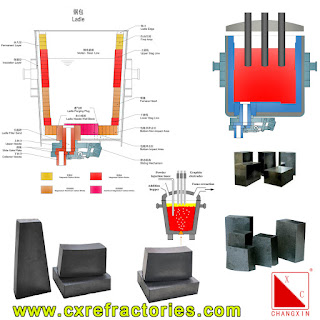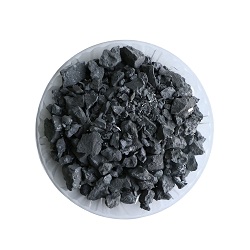The main raw materials of magnesia-carbon bricks include fused magnesia or sintered magnesia, flake graphite, organic binders and antioxidants.
Magnesia
Magnesia is the main raw material for the production of MgO-C bricks, which can be divided into fused magnesia and sintered magnesia. Compared with sintered magnesia, fused magnesia has the advantages of coarse periclase crystal grains and large particle bulk density, and is the main raw material used in the production of ladle magnesia carbon bricks. The production of ordinary magnesia refractory materials mainly requires high temperature strength and corrosion resistance for magnesia raw materials. Therefore, attention is paid to the purity of magnesia and the C/S ratio and B2O3 content in the chemical composition. With the development of the metallurgical industry, the smelting conditions are becoming more and more severe. The magnesia used in the MgO-C bricks used in metallurgical equipment (converter, electric furnace, ladle, etc.) Large crystal.
Carbon Source
Whether in traditional MgO-C bricks or in widely used low-carbon MgO-C bricks, flake graphite is mainly used as its carbon source. Graphite, as the main raw material for the production of MgO-C bricks, mainly benefits from its excellent physical properties: ① Non-wetting to slag. ②High thermal conductivity. ③ Low thermal expansion. In addition, graphite and refractory do not eutectic at high temperature, and the refractoriness is high. The purity of graphite has a great influence on the performance of MgO-C bricks. Generally, graphite with a carbon content greater than 95%, preferably greater than 98%, should be used.
In addition to graphite, carbon black is also commonly used in the production of magnesia carbon bricks. Carbon black is a highly dispersed black powdery carbonaceous material obtained by thermal decomposition or incomplete combustion of hydrocarbon hydrocarbons. 99%, high purity, high powder resistivity, high thermal stability, low thermal conductivity, is a difficult graphitization carbon. The addition of carbon black can effectively improve the spalling resistance of MgO-C bricks, increase the amount of residual carbon, and increase the density of bricks.
Binding Agent
The commonly used binders for the production of MgO-C bricks are coal tar, coal pitch and petroleum pitch, as well as special carbonaceous resins, polyols, pitch-modified phenolic resins, synthetic resins, etc. The binders used are of the following types:
1) Bituminous substances. Tar pitch is a thermoplastic material with the characteristics of high affinity with graphite and magnesium oxide, high residual carbon rate after carbonization, and low cost. It has been widely used in the past; However, tar pitch contains carcinogenic aromatic hydrocarbons, especially benzoβ content. High; the use of tar pitch is now decreasing due to increased environmental awareness.
2) Resin substances. Synthetic resin is prepared by the reaction of phenol and formaldehyde. It can be well mixed with refractory particles at room temperature. After carbonization, the residual carbon rate is high. It is the main binder for the current production of MgO-C bricks. The glassy network structure is not ideal for thermal shock resistance and oxidation resistance of refractories.
3) Substances obtained by modification on the basis of asphalt and resin. If the binder can form a mosaic structure and in-situ carbon fiber material after carbonization, the binder will improve the high temperature performance of the refractory material.
Antioxidants
In order to improve the oxidation resistance of MgO-C bricks, a small amount of additives are often added. Common additives are Si, Al, Mg, Al-Si, Al-Mg, Al-Mg-Ca, Si-Mg-Ca, SiC, B4C , BN and recently reported additives such as Al-BC and Al-SiC-C [5–7]. The working principle of additives can be roughly divided into two aspects: one is from the point of view of thermodynamics, that is, at the working temperature, additives or additives react with carbon to form other substances, and their affinity with oxygen is greater than that of carbon and oxygen. , which is oxidized in preference to carbon to protect carbon; On the other hand, from a kinetic point of view, the compounds generated by the reaction of additives with O2, CO or carbon change the microstructure of carbon composite refractories, such as increasing the Density, blocking pores, hindering the diffusion of oxygen and reaction products, etc.
We Changxing Refractory Material Co.,LTD is professional manufacturer and supplier of refractory materials for more than 30 years. Our high quality ladle magnesia carbon brick are good sold to many countries say South Africa, Bangladesh, Indonesia, Malaysia, etc. Shall any interests, welcome to contact us. Our team would make best to be your reliable partner!
Article Source:Brief introduction of raw materials for production of magnesia carbon bricks
Company name: Henan Changxing Refractory Materials Co.,Ltd
More refractory products:https://www.cxrefractories.com/en-product-solution
Email:info@cxrefractories.com
Website:https://www.cxrefractories.com






















